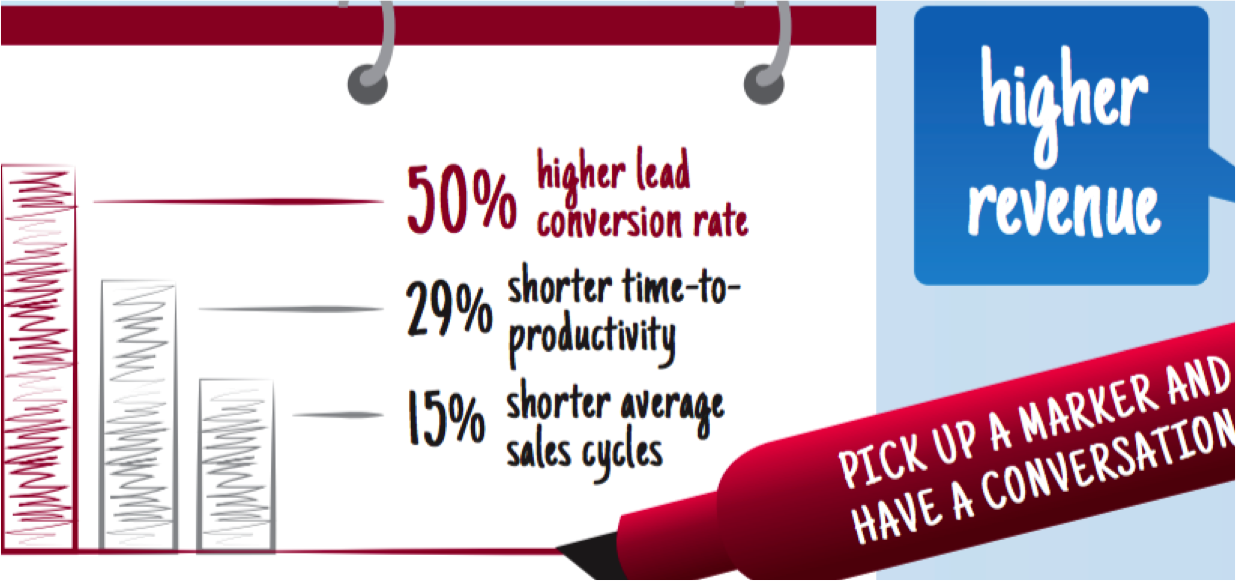Yesterday
Corporate Visions announced the results of its fourth quarter industry survey on visual storytelling, which was taken by more than 300 business-to-business (B2B) salespeople and marketers around the globe.
The findings reveal a lack of visual storytelling techniques among marketing and sales teams, and specifically, that only 13 percent of salespeople use an interactive writing surface such as a whiteboard to support their customer conversations.
To determine what role whiteboard selling techniques play in marketing and sales teams who work in complex B2B selling environments, Corporate Visions presented questions about the use of whiteboards, how they are created, by whom and why they are used. Notable findings from the Q4 survey include:
In fact, recent research by Aberdeen Group found that 53 percent of best-in-class companies identified creating more meaningful conversations as a top priority for increasing and sustaining revenue in an uncertain economy.
Furthermore, the firm found conducting an interactive whiteboard conversation (as opposed to a static presentation) leads to a 50 percent higher lead conversion rate, 29 percent shorter time-to-productivity and 15 percent average shorter sales cycle – helping to combat the meaningful conversation problem among businesses.
"It's clear from the results of this survey that visual storytelling techniques like whiteboarding are alarmingly underutilized by both marketing and sales teams," said Tim Riesterer, chief strategy and marketing officer, Corporate Visions. "87 percent of today's companies are using static techniques, rather than having intimate and visually interactive conversations, which is what whiteboarding allows companies to do. Marketing and sales teams need to work together to create pre-built whiteboards that are going to differentiate themselves in the sales cycle, which in turn, will help them close more deals."
The findings reveal a lack of visual storytelling techniques among marketing and sales teams, and specifically, that only 13 percent of salespeople use an interactive writing surface such as a whiteboard to support their customer conversations.
To determine what role whiteboard selling techniques play in marketing and sales teams who work in complex B2B selling environments, Corporate Visions presented questions about the use of whiteboards, how they are created, by whom and why they are used. Notable findings from the Q4 survey include:
Whiteboards are barely used
Respondents noted they use whiteboarding just 13 percent of the time to tell a visual story as part of sales conversations. The other tools mentioned most often were PowerPoint (33 percent), phone (26 percent) and in-person conversations (27 percent), which employ little to no visual components. This means salespeople are losing out on the opportunity to present ideas in a more engaging way, and to differentiate their messages, conversations and presentations to customers and prospects.Whiteboarding is not an on-purpose effort
Of those who actually report using whiteboards, 51 percent say they create them ad-hoc or borrow them from their peers. Only 24 percent are pre-built and approved as part of a strategic marketing and sales support program. For whiteboarding to be effective, marketing needs to develop the messages and tools alongside the sales team to make sure everyone is delivering a consistent, high-quality message. By pre-building whiteboards, salespeople are given the ability to deliver a simple, repeatable story with confidence and create a differentiated experience in the buying cycle.Whiteboards, when used effectively, can be leveraged in various ways –
Respondents who use whiteboards specified they are essential to the buying cycle in a number of different ways, including:- 25 percent – presenting/differentiating their solution from the competition
- 17 percent – illustrating the business impact of their solution
- 8 percent – demand generation
- 6 percent – explaining the implementation process
In fact, recent research by Aberdeen Group found that 53 percent of best-in-class companies identified creating more meaningful conversations as a top priority for increasing and sustaining revenue in an uncertain economy.
Furthermore, the firm found conducting an interactive whiteboard conversation (as opposed to a static presentation) leads to a 50 percent higher lead conversion rate, 29 percent shorter time-to-productivity and 15 percent average shorter sales cycle – helping to combat the meaningful conversation problem among businesses.
Aberdeen Group Whiteboarding Survey Dec 2012
"It's clear from the results of this survey that visual storytelling techniques like whiteboarding are alarmingly underutilized by both marketing and sales teams," said Tim Riesterer, chief strategy and marketing officer, Corporate Visions. "87 percent of today's companies are using static techniques, rather than having intimate and visually interactive conversations, which is what whiteboarding allows companies to do. Marketing and sales teams need to work together to create pre-built whiteboards that are going to differentiate themselves in the sales cycle, which in turn, will help them close more deals."





